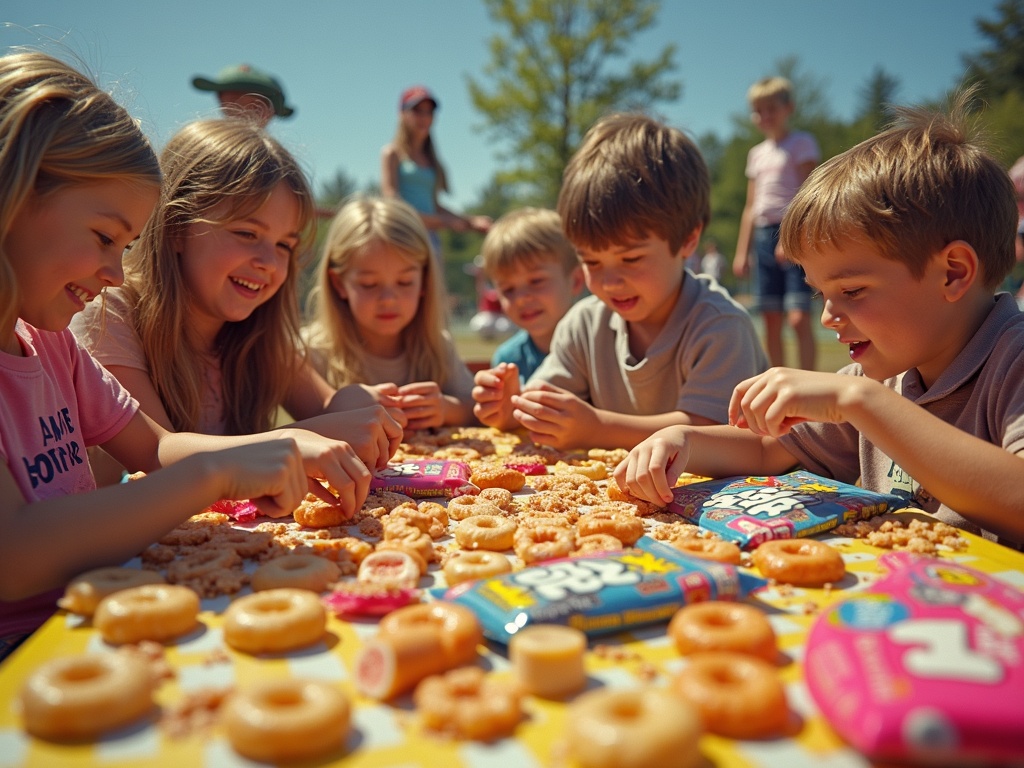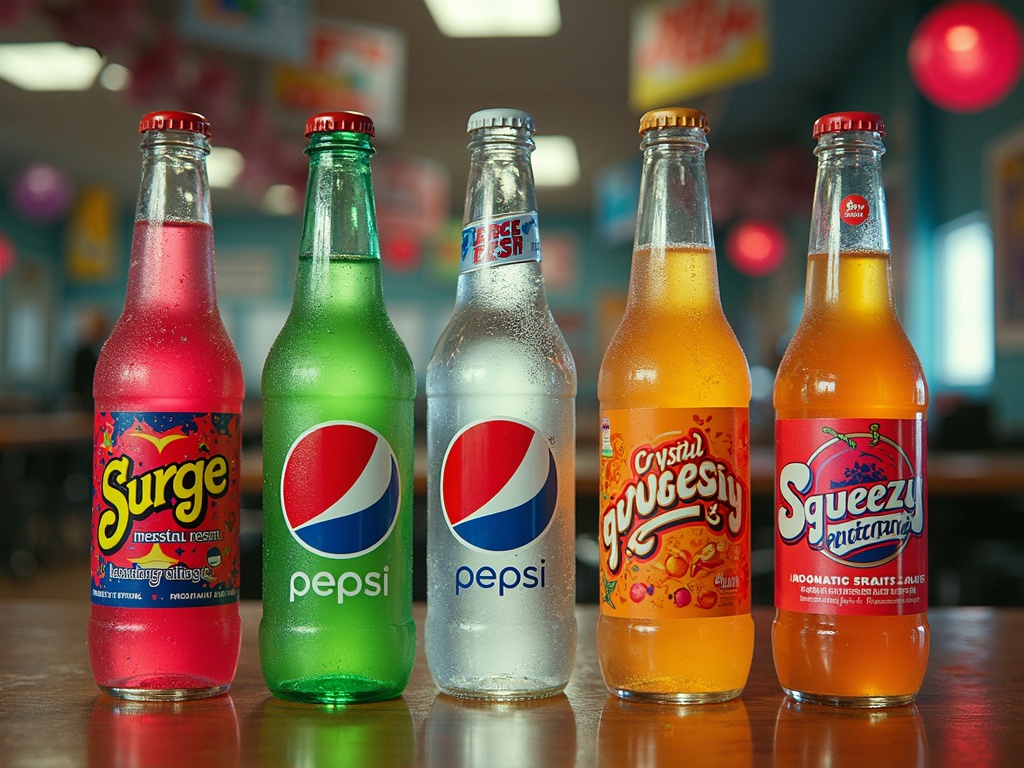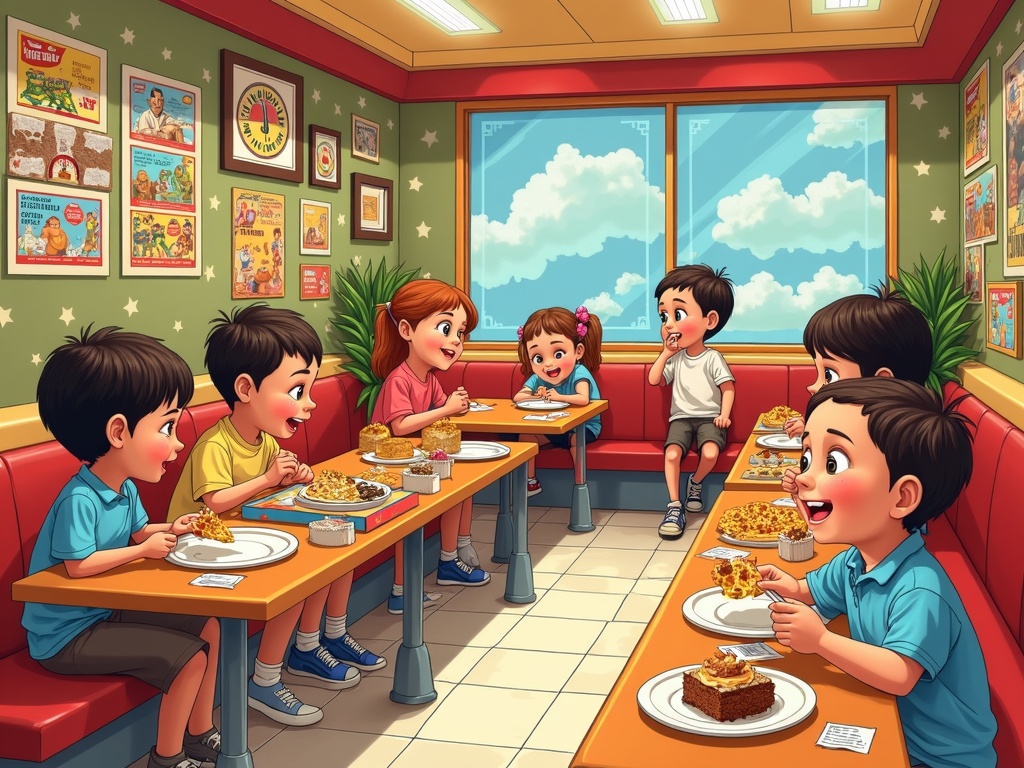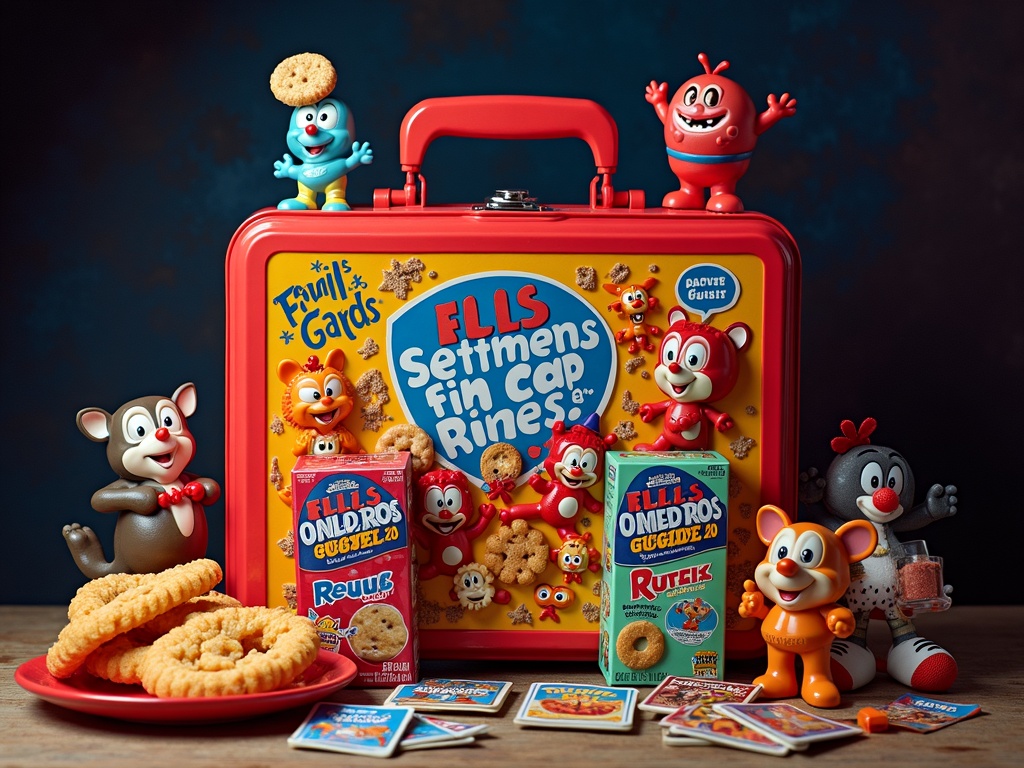The ’90s snack era created an unprecedented cultural phenomenon, with treats like Dunkaroos reaching $250 million in sales while transforming ordinary eating into interactive experiences. These weren’t just food products but social currencies that built playground economies and brand loyalties that continue to influence consumer choices decades later, as adults now share their childhood favorites with a new generation.
Find In This Article
Key Takeaways
- Iconic ’90s treats succeeded through vibrant packaging, memorable mascots, and interactive eating experiences that made snacking both fun and social.
- The beverage revolution introduced products like Surge and Crystal Pepsi that served as identity markers, with marketing campaigns centered around extreme sports and rebellious youth culture.
- School lunchboxes became trading grounds for coveted items like Dunkaroos and Gushers, establishing an unofficial currency system based on snack desirability.
- Fast food chains mastered cross-promotional marketing with pop culture, growing to a $110 billion industry through collectible toys and movie tie-ins.
- Breakfast cereals transformed morning routines through character-driven marketing and strategic Saturday morning cartoon advertising, generating $8.4 billion in revenue by 1995.
Why These Treats Defined a Generation
The 1990s represented a golden era for snack foods, with unprecedented sales figures that reflected their cultural impact. Dunkaroos, the cookie-and-frosting combination that became a lunchbox staple, peaked at an impressive $250 million in sales during their heyday. This wasn’t just about satisfying sweet cravings—these treats became embedded in the cultural fabric of an entire generation.
Cultural Impact and Marketing Magic
I’ve watched how these iconic brands shaped childhood experiences through clever marketing strategies. Products like Gushers with their “fruit explosion” and the pliable, peelable Fruit Roll-Ups weren’t just snacks—they were experiences that created lasting memories. The marketing teams behind these treats understood something fundamental: children wanted food that was interactive and fun.
The success of these treats stemmed from several key factors:
- Vibrant, eye-catching packaging that stood out on store shelves
- Memorable mascots and characters that children could identify with
- Interactive eating experiences (peeling, stretching, dipping)
- Television commercials that portrayed the snacks as part of an exciting lifestyle
- Trading potential that created playground currency
The financial impact was staggering, with combined annual revenue across snack categories exceeding $8.4 billion by 1995. This commercial success mirrored the deep emotional connections forming between young consumers and these brands.
Today’s resurgence of ’90s treats isn’t coincidental—it’s calculated nostalgia marketing at work. Many adults who grew up during this period now seek out these familiar flavors, looking to recreate those moments of joy. This same nostalgic appeal is what makes treats like pizza rolls from the air fryer so popular today—they connect us to simpler times.
The loyalty these brands built continues to influence buying decisions decades later. Parents who once begged for Cosmic Brownies now share them with their own children, creating new traditions while honoring old ones. The emotional satisfaction from indulging in treats like fudgy brownies or a creamy Oreo milkshake taps into this same psychological comfort zone.
What made these ’90s treats truly defining wasn’t just their flavors but their ability to transform snacking into social experiences. They weren’t just consumed—they were collected, traded, shown off, and discussed. The brands that understood this connection between food and identity created more than customers; they created lifelong ambassadors who continue to crave these distinctive flavors decades later.

The Beverage Revolution That Changed Everything
The ’90s wasn’t just about boy bands and baggy jeans – it marked a complete revolution in what we drank. I still remember the first time I tried Surge, that electric green soda that promised enough caffeine and sugar to keep me gaming all night. The beverage landscape transformed dramatically during this decade, creating entirely new categories and marketing approaches that still influence today’s drink industry.
Neon Colors and Extreme Branding
Surge, Crystal Pepsi, and Squeezy Fruitopia weren’t just new drinks – they were cultural phenomena. These beverages broke traditional molds with their bold colors, unique packaging, and flavor profiles designed to capture young consumers’ attention. Crystal Pepsi’s clear cola concept challenged our expectations, while Fruitopia’s squeeze bottles and psychedelic branding made drinking juice feel like a rebellious act.
The marketing campaigns behind these drinks were unlike anything we’d seen before. Beverage companies invested millions in commercials featuring extreme sports, rebellious teenagers, and cutting-edge music. These weren’t just advertisements – they were lifestyle statements designed to make young consumers feel part of something bigger. Surge commercials, for instance, featured teenagers engaging in adrenaline-pumping activities that perfectly matched the drink’s high-energy positioning.
Companies cleverly positioned these beverages as identity markers. Drinking Surge meant you were edgy and energetic, while Fruitopia appealed to the more artistic, free-spirited types. The strategies worked brilliantly – these drinks quickly became status symbols in school cafeterias across America.
The Power of Nostalgia and Digital Revival
What makes these ’90s beverages particularly fascinating is their remarkable comeback stories. After disappearing from shelves, many of these drinks developed cult followings that eventually led to their revival. The “Save Surge” movement stands as one of the most successful consumer-driven campaigns in beverage history. When Coca-Cola finally reintroduced Surge in 2014, it generated millions in online sales within just 24 hours – proof of nostalgia’s powerful economic force.
Social media played a crucial role in these revivals. Facebook groups dedicated to discontinued ’90s beverages gathered hundreds of thousands of members, creating ready-made customer bases for companies willing to bring back these beloved brands. The success of these campaigns taught beverage companies an important lesson: nostalgia sells.
The revival strategy expanded beyond just bringing back old favorites. Companies began introducing “throwback” editions featuring original packaging and formulations. PepsiCo’s limited-time releases of retro Mountain Dew designs created massive demand among collectors and nostalgic drinkers alike.
I’ve noticed this nostalgia trend continues to influence the industry today. Modern beverage innovations often incorporate elements from these ’90s classics, whether it’s the extreme caffeine content popularized by Surge or the unconventional packaging introduced by Fruitopia. Even contemporary Oreo milkshake recipes tap into this same nostalgia factor, combining beloved flavors in new ways.
The ’90s beverage revolution wasn’t just about quirky drinks – it fundamentally changed how products were marketed, packaged, and positioned. These drinks taught us that beverages could be more than refreshment; they could be fashion statements, identity markers, and cultural touchstones.
Today’s specialty drinks market owes much to this era. From fudgy brownie inspired beverages to pizza roll flavored energy drinks (yes, that’s a real thing), the experimental spirit of ’90s beverages lives on in today’s most innovative products.
These nostalgic beverages didn’t just satisfy our thirst – they created lasting memories and shaped an entire generation’s relationship with food and drink marketing. Their legacy continues to bubble up in contemporary beverage trends, proving that sometimes the most significant innovations come in the most colorful packages.

Most Popular Snacks You Couldn’t Resist
The ’90s snack scene created a playground of flavors that defined a generation. I remember saving my allowance just to stock up on the latest candy crazes that swept through school hallways and neighborhood hangouts.
Candy Kingdom Favorites
Ring Pops, Pop Rocks, and Warheads weren’t just candies—they were experiences. Ring Pops turned jewelry into an edible accessory, while Pop Rocks created that distinctive sizzling sensation that made your friends gather around just to hear the crackling sounds. Warheads took the concept of sour to uncomfortable yet strangely addictive extremes.
The candy industry understood our weakness for these novelty treats, with sales reaching an impressive $17 billion by 1999. This figure reflected not just casual purchases but a genuine cultural phenomenon that had children and teens eagerly awaiting the next innovation.
I still crave those fudgy chocolate treats that complemented the candy assortment in my childhood stash—they were the perfect balance to all that sugary sourness.
Lunchbox Trading Economy
Dunkaroos and Gushers created an unofficial currency in school cafeterias nationwide. The vanilla frosting with cookie dippers made Dunkaroos the gold standard of lunchbox trades, often worth multiple other snacks in the playground bartering system.
The social element of ’90s snacking can’t be overstated. Sharing a pack of cookies for milkshake dipping or trading fruit snacks created bonds that sometimes outlasted childhood friendships. The collective experience of trying a new flavor or rediscovering an old favorite built community through shared tastes.
Manufacturers cleverly introduced collector’s editions and limited-time offerings that turned regular snack runs into treasure hunts. Special edition packaging featuring popular movies or TV shows transformed ordinary treats into must-have items. This marketing approach made even basic snacks feel exclusive and drove repeat purchases as kids attempted to collect complete sets.
The anticipation of trying unusual flavor combinations like those found in crispy pizza-flavored snacks became part of the excitement. Food companies understood that novelty and surprise were powerful motivators for young consumers.
Looking back, these weren’t just snacks—they were cultural artifacts that captured a specific moment in time, creating shared memories for an entire generation who can still recite jingles and describe packaging in vivid detail decades later.
Fast Food’s Golden Age of Innovation
The 1990s marked a transformative era for fast food chains, with the industry growing to a staggering $110 billion in value by the end of the decade. I remember this period vividly – it wasn’t just about the food; it was about the experience that came with it.
Marketing Revolution Through Entertainment
Fast food brands in the ’90s mastered the art of collaboration with pop culture phenomena. Pizza Hut’s partnership with “Teenage Mutant Ninja Turtles” wasn’t just a simple promotion – it revolutionized how restaurants connected with younger audiences. This clever tie-in created a blueprint that countless fast food chains have followed since.
The cross-promotional marketing strategies developed during this time transformed how brands engaged with customers. These campaigns did more than sell food; they created memorable experiences that many of us still reminisce about today. Much like how a perfectly made pizza roll from an air fryer brings back that nostalgic crunch, these campaigns tapped into emotional connections.
Kid-focused meal promotions reached their zenith during this golden age. Collectible toys, movie character cups, and themed packaging became standard offerings. These items weren’t just afterthoughts – they were carefully designed collectibles that kids eagerly anticipated. The joy of opening a new toy rivaled the pleasure of enjoying those fudgy brownies we’d beg our parents for as dessert.
The influence of ’90s fast food marketing continues to shape today’s strategies. Modern promotions still follow the template established during this innovative decade, though with digital twists. The foundation built then remains relevant even as we’ve moved into an era of social media and Oreo milkshake viral sensations.
The ’90s fast food explosion wasn’t just about selling hamburgers and fries – it represented a perfect storm of entertainment, collectibility, and family-friendly marketing that created lifelong brand loyalties. Many of today’s parents introducing their children to these same chains are tapping into their own childhood memories, creating a multi-generational connection that few other industries can claim.

The Breakfast Table Revolution
The ’90s completely changed how kids experienced breakfast. Colorful cereals like Trix, Cinnamon Toast Crunch, and Froot Loops weren’t just food—they were entertainment in a bowl that turned ordinary mornings into adventures. These cereals introduced wild shapes, vibrant colors, and flavor combinations that made breakfast exciting.
These innovative breakfast treats weren’t just popular—they were financial powerhouses. In 1995, the cereal market generated an impressive $8.4 billion in U.S. revenue. This wasn’t just about selling food; it was about creating an experience that kids couldn’t resist and parents couldn’t ignore.
Mascots and Marketing Magic
Cereal companies mastered character-driven marketing in ways that still influence brands today. I can still picture the Trix Rabbit’s desperate attempts to get his paws on a bowl, or the Cinnamon Toast Crunch squares with their googly eyes. These weren’t just mascots—they were personalities that created emotional connections with kids across America.
The real genius came through Saturday morning cartoon advertising. Companies strategically placed their commercials between popular shows, creating the perfect storm of entertainment and product placement. Kids would be watching their favorite cartoons and suddenly see the Trix Rabbit or Toucan Sam having adventures that made their cereals seem like the most exciting food option possible.
This character-based approach to marketing has shaped how companies connect with consumers today. Modern brands still use mascots and characters to build relationships with customers, though they’ve expanded beyond TV to social media and digital platforms. The tactics that worked on ’90s kids eating cereal before school have evolved into sophisticated marketing strategies that drive today’s food trends.
The nostalgia these cereals trigger remains powerful. Just like the warm, fudgy sensation of homemade brownies or the creamy satisfaction of an Oreo milkshake, these breakfast classics transport us back to simpler times. Even modern comfort foods like air-fried pizza rolls can’t quite capture the magic of those original ’90s breakfast table experiences.
The breakfast revolution of the ’90s wasn’t just about selling sugary cereals—it created cultural touchpoints that defined a generation and transformed how we think about breakfast marketing forever.
Sources:
Food Network: The Snack History: How ’90s Snacks Were Born
Statista Report: Cereal & Snacks Market Trends 1990-1999
Beverage Digest: Beverage Boom: The Rise and Fall of ’90s Drinks
Journal of Consumer Marketing: Marketing Strategies in Fast Food: A Historical Perspective
Candy Industry Magazine: Candy in the ’90s: A Sweet Memory

